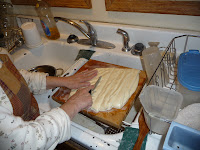We've been asked countless times how we make our field pens.
It is that time of year for the boring part of what we do. I am so proud of
Armand and our son for making this time for pen maintenance. Right now, they are making two brand new pens in our front yard (does a
farm have a front yard?).
We'll be needing these pens for the turkeys as we thin them out and put fewer into each pen.
They start with a wooden frame and they arch 20' sticks of PVC to make the "roof".
They
put chicken netting about 1/2 way up and hardware "cloth" on the bottom
few inches to keep the predators out. They will cover the pvc with a
used billboard vinyl. You can see that the bottom of the pens is open,
thus allowing the birds to have access to fresh grass and bugs at all
times. The ends are open (but covered with chicken netting) allowing the birds access to sunshine and weather.
The guys haven't covered the tops with a vinyl yet. Maybe I can add a couple of pictures when they do. I couldn't figure out how to get any of the pictures to hyperlink to a larger picture, so what you see is what you get.
At current prices, it costs us about $100 to build a pen. They last for
several years with minor repairs and maintenance. If you run 75 birds to
a pen, and run 6 batches a season, that's 450 birds using the pen. That
works out to be 22¢ a bird to live in that pen for only one season. If you use that pen for
TWO seasons, now it's only 11¢ a bird to build that nice pen. All of a
sudden, it's not that expensive.
 |
| Wooden frame with arched sticks of PVC for roof |
|
|
|
|
 |
| Can you see the corner brace in the corner? We brace 2 corners. |
 |
| Chicken netting goes 1/2 way up on both sides. Armand is putting chicken netting on the back wall. | | |
|
|
|
|
|
 |
| Hardware "cloth" to keep predators out. |
 |
| Our son is building a door. |
 |
| Attaching the PVC door |
 |
| He's proud of what he does! |




















